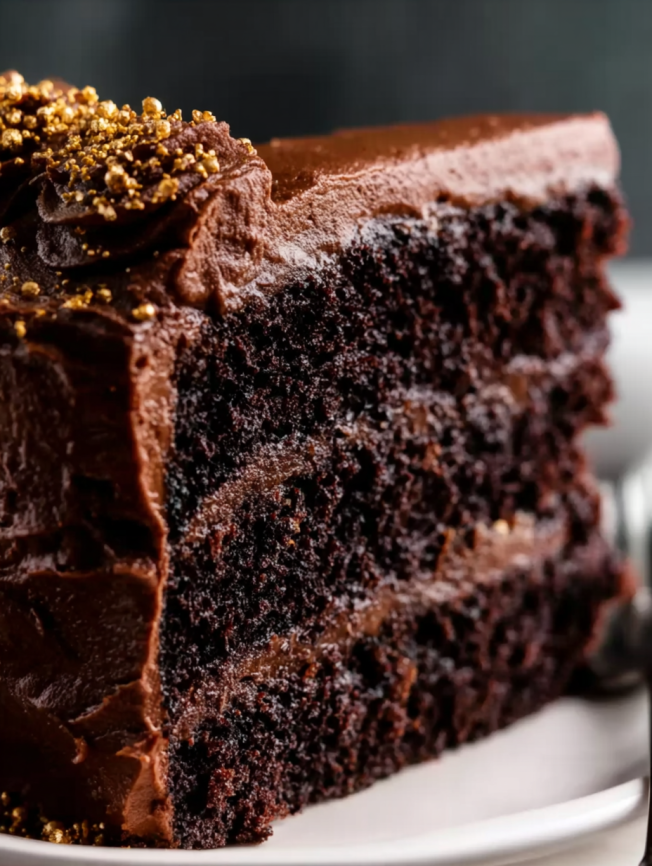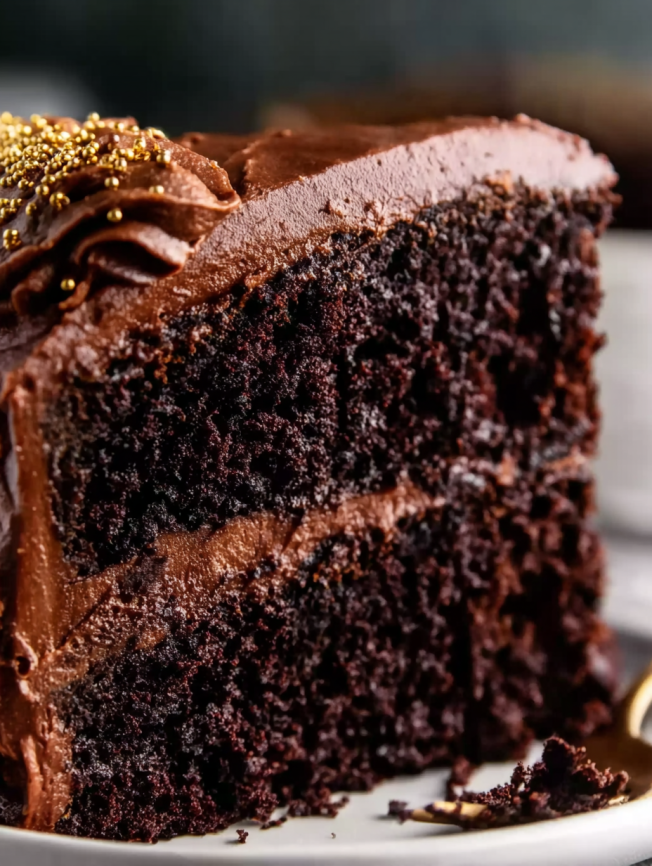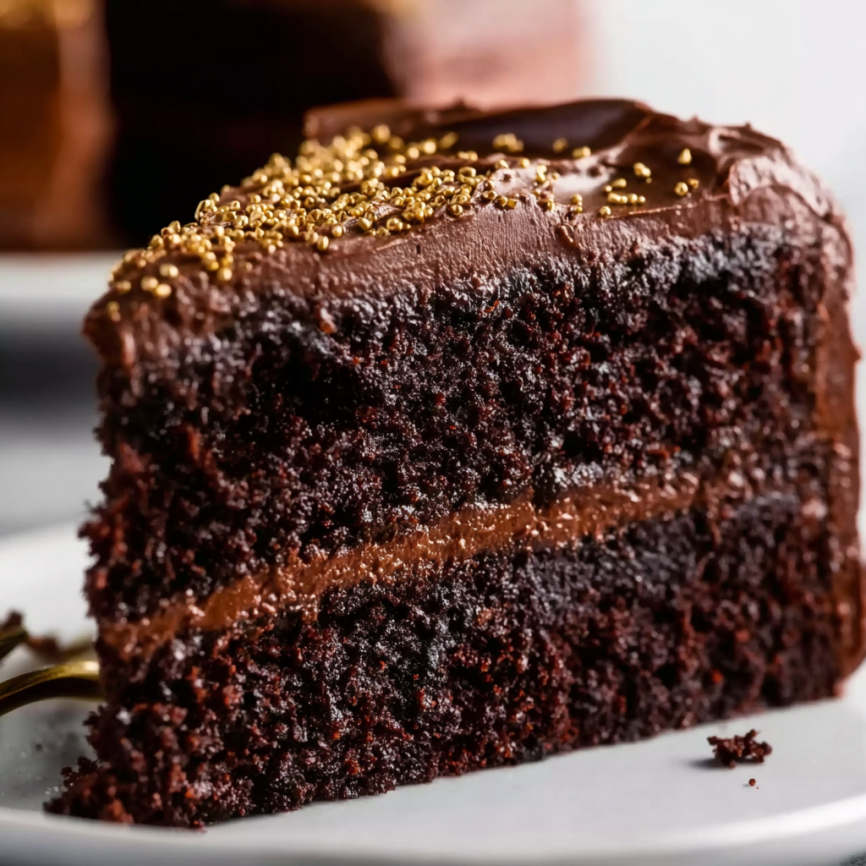My introduction to Guinness chocolate cake came during a memorable St. Patrick’s Day celebration at a friend’s house. Initially skeptical about combining beer with chocolate, I took one bite and was completely converted. The deep, malty complexity of the reduced Guinness didn’t just complement the chocolate – it elevated it to entirely new heights. Unlike many beer-flavored desserts that taste gimmicky, this cake achieves something truly special: the Guinness adds genuine depth and richness that makes you wonder why chocolate and stout aren’t paired more often. After years of perfecting this recipe, I can confidently say it’s become my go-to celebration cake, whether for St. Patrick’s Day or any occasion that calls for something genuinely spectacular.
Why This Guinness Chocolate Cake Is Absolutely Irresistible
This cake represents the perfect marriage of two beloved indulgences, creating something far greater than the sum of its parts. First and foremost, the secret lies in reducing the Guinness down to concentrate its flavors – this crucial step transforms the beer from a liquid that would make the cake soggy into a flavor powerhouse that intensifies the chocolate experience.
Moreover, the cake’s texture achieves that perfect balance between dense richness and tender crumb that makes every bite satisfying without being heavy. The combination of sour cream, buttermilk, and oil creates exceptional moisture that keeps the cake fresh for days, while the reduced stout adds complexity that develops and deepens over time.
Furthermore, the chocolate cream cheese frosting provides the ideal complement to the cake’s intensity. The tangy cream cheese brightens the overall flavor profile while the additional Guinness in the frosting creates perfect harmony between all components. The result is a sophisticated dessert that appeals to both chocolate lovers and those who appreciate unique flavor combinations.
The Science Behind Reducing Guinness for Maximum Impact
The key to exceptional Guinness flavor in baked goods lies in understanding how reduction concentrates taste while eliminating excess liquid. When you simmer Guinness for approximately 30 minutes, the alcohol evaporates while the malty, slightly bitter flavors become intensely concentrated.
This process transforms roughly 24 ounces of beer into about ¾ cup of rich, syrupy liquid that packs incredible flavor punch. Additionally, using the reduced Guinness while it’s still hot helps “bloom” the cocoa powder in the batter, which enhances the chocolate flavor and creates better overall integration of ingredients.
Understanding the Perfect Chocolate Cake Structure
Creating an exceptionally moist chocolate cake requires balancing multiple liquid ingredients without compromising structural integrity. This recipe masterfully combines oil for moisture retention, sour cream for tanginess and richness, and buttermilk for tender crumb development.
The inclusion of both baking soda and baking powder ensures proper lift, while the natural cocoa powder contributes to the cake’s deep chocolate flavor. However, cocoa powder is less structurally supportive than flour, which explains why rich chocolate cakes sometimes develop slight centers – this is completely normal and doesn’t affect the taste or overall success.
Essential Ingredients for Success
For the Chocolate Cake:
- Two 11.2-12 ounce bottles of Guinness beer
- 1¾ cups (219g) all-purpose flour, spooned and leveled
- ¾ cup (62g) unsweetened natural cocoa powder
- 1¾ cups (350g) granulated sugar
- 2 teaspoons baking soda
- 1 teaspoon baking powder
- 1 teaspoon salt
- 2 teaspoons espresso powder (optional but recommended)
- ½ cup (120ml) vegetable oil
- ¾ cup (180g) full-fat sour cream, room temperature
- 2 large eggs, room temperature
- 2 teaspoons pure vanilla extract
- ½ cup (120ml) buttermilk, room temperature
For the Chocolate Guinness Frosting:
- 8 ounces (226g) full-fat brick cream cheese, softened
- ½ cup (113g) unsalted butter, softened
- 2½ cups (300g) confectioners’ sugar
- ½ cup (41g) unsweetened cocoa powder
- 3 tablespoons cooled reduced Guinness
- Pinch of salt
- Optional: gold sprinkles for garnish
Perfect Serving Suggestions:
This rich cake pairs wonderfully with a cup of strong coffee, Irish whiskey, or even a small glass of Guinness itself. For special occasions, consider serving alongside vanilla ice cream or fresh berries to balance the intensity.

Step-by-Step Cake Creation Process
The Crucial Guinness Reduction
Begin by pouring both bottles of Guinness into a large saucepan and bringing to a rolling boil over medium-high heat. Once boiling, reduce the heat to medium-low and allow the beer to simmer steadily until it reduces to approximately ¾ cup, which typically takes about 30 minutes.
This reduction process is absolutely critical – don’t rush it by using higher heat, as this can create bitter, burnt flavors. You’ll use ½ cup of the hot reduced Guinness immediately in the cake batter, while reserving the remainder to cool for the frosting.
Preparing Your Baking Setup
While the Guinness reduces, preheat your oven to 350°F (177°C) and prepare two 9-inch round cake pans. Grease them thoroughly, line with parchment paper rounds, then grease the parchment as well. This double-greasing method ensures effortless cake removal without any sticking.
Creating the Perfect Dry Mixture
In a large bowl, whisk together flour, cocoa powder, sugar, baking soda, baking powder, salt, and espresso powder (if using) until completely combined. The espresso powder enhances chocolate flavor without adding coffee taste – don’t skip it if you have it available.
Mastering the Wet Ingredient Combination
Using an electric mixer or whisk, combine oil, sour cream, eggs, and vanilla on medium-high speed until smooth and well incorporated. Add the buttermilk and mix until just combined – overmixing at this stage can create tough cake texture.
The Critical Integration Step
Pour the wet ingredients into the dry ingredients and give everything a preliminary mix. Then, add exactly ½ cup of the hot reduced Guinness and mix on low speed until the batter is completely smooth. The batter will be quite thin – this is perfect and contributes to the cake’s exceptional moisture.
Baking for Optimal Results
Even Distribution and Timing
Divide the batter evenly between your prepared pans – you should have approximately 6 cups of batter total. Bake for 25-28 minutes, but start checking at 25 minutes with a toothpick inserted in the center. The cake is done when the toothpick comes out clean or with just a few moist crumbs.
Proper Cooling Technique
Allow the cakes to cool completely in their pans on wire racks before attempting removal. This complete cooling prevents breaking and ensures the cakes maintain their shape during frosting application.
Crafting the Signature Frosting
Achieving Silky Smoothness
Using an electric mixer with paddle attachment, beat the softened cream cheese and butter together on medium speed for about 2 minutes until completely smooth and creamy. Proper softening is crucial – if the ingredients are too cold, the frosting will be lumpy.
Building Flavor Complexity
Add confectioners’ sugar, cocoa powder, 3 tablespoons of cooled reduced Guinness, and a pinch of salt. Beat on low speed initially to prevent sugar clouds, then increase to high speed and beat for exactly 1 minute. Avoid over-whipping, which can make the frosting too loose.
Consistency Adjustments
Taste and adjust the frosting as needed. If it seems too thin, add more confectioners’ sugar or cocoa powder gradually. If too thick, incorporate additional cooled reduced Guinness one tablespoon at a time until you achieve the perfect spreading consistency.
Professional Assembly Techniques
Creating Level Layers
If your cooled cakes have domed tops, use a large serrated knife to carefully level them, creating flat surfaces for even assembly. Save these scraps for snacking or crumble them over the finished cake for rustic garnish.
Strategic Frosting Distribution
Place the first layer on your serving plate and spread approximately 1 cup of frosting evenly across the top. Add the second layer and apply the remaining frosting to the top and sides, using a bench scraper for smooth sides if desired.
Final Presentation Touch
Consider piping decorative borders with any remaining frosting, and add gold sprinkles for elegant St. Patrick’s Day appeal. Refrigerate the assembled cake for at least 30-60 minutes before serving to help everything set properly.
Creative Variations to Explore
Salted Caramel Guinness Cake
Add a layer of homemade salted caramel between the cake layers and drizzle more over the finished cake. The sweet-salty combination pairs beautifully with the malty Guinness flavors.
Irish Coffee Version
Add 1 tablespoon of instant coffee to the reduced Guinness and incorporate Irish whiskey into the frosting for an adult twist that captures the essence of Irish coffee in cake form.
Individual Portion Option
Transform this recipe into elegant cupcakes for easier serving at parties. The batter makes approximately 24 standard cupcakes, baked at the same temperature for 18-22 minutes.
Make-Ahead Strategies for Stress-Free Entertaining
Component Preparation
The Guinness reduction can be completed 2-3 days in advance and stored covered in the refrigerator. Similarly, baked cake layers wrap well and can be refrigerated for up to 2 days or frozen for up to 3 months before frosting.
Frosting Timeline
Prepare the frosting up to 3 days ahead, storing it covered in the refrigerator. Bring to room temperature and re-whip briefly before using to restore optimal consistency.
Complete Assembly Options
The fully assembled cake actually improves overnight as flavors meld together. Store it covered in the refrigerator and bring to room temperature before serving, or serve it chilled for a denser, fudgier texture.
Professional Tips for Exceptional Results
Success with this cake depends heavily on proper ingredient temperatures and timing. All dairy ingredients must be at room temperature for smooth mixing, while the reduced Guinness needs to be hot when added to help bloom the cocoa powder effectively.
Don’t worry if your cake layers sink slightly in the center – this is completely normal with moisture-rich chocolate cakes and doesn’t affect the final result. The frosting will easily cover any minor imperfections while the flavor remains absolutely perfect.
Storage and Serving Guidelines
This cake actually improves with time, as the Guinness flavors continue to develop and meld with the chocolate. Store covered cake in the refrigerator for up to 5 days, though it rarely lasts that long once people discover how incredible it tastes.
For the best texture, remove the cake from refrigeration about 30 minutes before serving to allow it to come closer to room temperature. However, it’s equally delicious served chilled for those who prefer denser, fudgier textures.
Troubleshooting Common Challenges
If your reduced Guinness becomes too thick or syrupy, simply add a tablespoon of hot water to thin it out slightly. Conversely, if it seems too thin after the full reduction time, continue simmering for a few more minutes until it reaches the proper consistency.
For frosting that seems too sweet, add additional pinches of salt until the flavor balances properly. The slight bitterness from the reduced Guinness should complement rather than compete with the sweetness of the confectioners’ sugar.

Frequently Asked Questions
Can I substitute a different type of beer for the Guinness? While you can use other stouts or porters, Guinness provides the ideal flavor profile for this cake. Its distinctive malty sweetness and slight bitterness create the perfect complement to chocolate that other beers may not achieve as successfully.
Will this cake taste strongly of beer? Not at all! The reduction process concentrates the malty flavors while eliminating the sharp alcoholic bite. The result adds depth and complexity to the chocolate rather than an obvious beer taste that might be off-putting to some.
Can I make this as a sheet cake instead of layer cake? Absolutely! Pour all the batter into a greased 9×13-inch pan and bake for 35-40 minutes at the same temperature. This creates a convenient single-layer cake that’s perfect for casual gatherings or potluck events.
What if I don’t have buttermilk on hand? Create a simple substitute by adding 1 teaspoon of white vinegar or lemon juice to a measuring cup, then adding enough whole milk to reach ½ cup total. Let it sit for 5 minutes until slightly curdled before using.
How do I know when the Guinness is reduced enough? You’re looking for approximately ¾ cup of liquid remaining from the original 24 ounces. It should be noticeably thicker and more syrupy than regular beer, with concentrated flavors that smell rich and malty rather than sharp.
Can this cake be made gluten-free? You can substitute a high-quality 1:1 gluten-free flour blend for the all-purpose flour, though the texture may be slightly different. Ensure all other ingredients are certified gluten-free, including the Guinness (traditional Guinness contains barley and is not gluten-free).
Prep Time: 1 hour
Cook Time: 27 minutes
Total Time: 5 hours (includes chilling)
Calories: 485 kcal per slice
Servings: 12-16 slices

